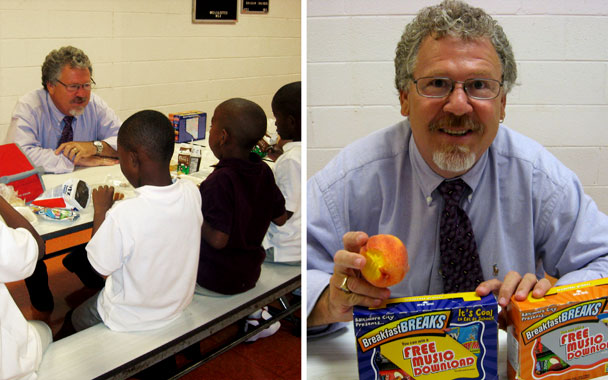Walking through a field of rich soil at Arnold Farms on Maryland’s rural Eastern Shore, Tony Geraci plucks a ripe tomato off the vine and bites in. As the juices spill out, Geraci, the new top chef for the Baltimore school system, smiles broadly. “I’m thinking about a fresh tomato salad with basil and mozzarella,” he says. Soon, he’s talking about raw cauliflower with a dipping sauce; super-sweet corn on the cob shaved into crab soup; and his recipe for vegetarian loaf with lentils, garlic, and onions.
Lunchtime for Baltimore’s 82,000 students may never be the same. Long a place where the typical diet centered on snack foods, soda, and fried chicken in a box from the corner store, Baltimore is going Berkeley.
“Anything is possible,” says Geraci, a 51-year-old New Orleans native who came to Baltimore from New Hampshire, where he gave school lunchroom menus a major makeover and then ran a program to prepare low-income and developmentally disabled adults for careers in the culinary field. Geraci has vowed that within his first year in Charm City he will wipe out most of the frozen lunches that one teacher describes as “breaded bread with bread sauce,” and replace them with Maryland-grown farm specialties at least three days a week. He’s enlisting farms like Arnold to sell produce to the schools at fair market value, which helps the farmers as well as his mission.
Gone are the days of rubbery chicken nuggets and fries. In their place the chef plans to offer roasted poultry and baked herbed potatoes. Pizza will now be made with whole-grain crust, and each slice will come with a garden salad and fresh fruit. It’s all in keeping with strict USDA guidelines for school lunches, Geraci says. For instance, he explains that government cheese will be used to make dipping sauce for fresh broccoli spears, rather than goopy macaroni and cheese. And USDA-provided rice and beans will be combined to make red beans and rice (on Mondays, of course).
At the same time, he will introduce Baltimore schoolchildren to a new way of healthy eating in a system that, because of the city’s high poverty rate and large number of homeless students, offers many their only meal of the day. The city’s schools have Maryland’s highest rate of overweight children and teens enrolled, mainly because most live in poverty and don’t have healthy eating habits, Geraci says. A report released in June by the Baltimore City Health Department showed that one-fifth of city high school students were classified as obese in 2007. “This has to change,” Geraci says. “We’ve lost an entire generation of children to obesity and poor nutrition, and we’re about to lose another one if we don’t reach our hands into the fire and pull them back out and start doing the right thing.”
Beginning today, the first day of Baltimore’s academic year, the farm-fresh haul will appear on lunch trays as the push for a healthier palate moves into the schools. Around 11:30 this morning, Geraci sat at a table in the cafeteria of Calvin M. Rodwell Elementary School in west Baltimore and encouraged students to try the fresh peaches on their trays. An arrangement with Baugher’s Orchards in rural Carroll County, MD had brought 82,000 pieces of the fruit into Baltimore’s schools for opening day. “I just had two first-graders tell me that they had never had a fresh peach,” Geraci said. “And that’s my point. Kids need to know what real food is.” Pointing to a second-grader who was digging in, he added: “When I see this kid right here with a face full of peach juice, it brings joy to my heart. Look at that smile. Look at that face. That’s why I’m here.”



 Pinterest
Pinterest


